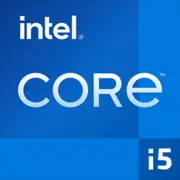Intel Core i5-4670

Intel Core i5-4670: Review and Relevance in 2025
Haswell Architecture, 22 nm, 4 Cores — Is it worth considering this processor today?
Key Specifications: The Legacy of Haswell
The Intel Core i5-4670, released in 2013, belongs to the fourth generation of Haswell architecture. Despite its age, it remains popular in the secondary market due to its reliability.
- Manufacturing Process and Energy Efficiency: The 22 nm technology ensures a TDP of 84 W. For its time, this was a balance between performance and heat generation.
- 4 Cores, 4 Threads: The absence of Hyper-Threading limits multitasking capabilities, but for simple tasks, the cores suffice.
- L3 Cache of 6 MB: Speeds up processing of frequently used data.
- Integrated Intel HD 4600 Graphics: Supports 4K via DisplayPort but is weak for gaming (e.g., CS:2 at low settings — 30-40 FPS).
- Performance: Geekbench 6 scores — 1169 (single-core), 3279 (multi-core). For comparison, the modern budget Core i3-13100 (2023) scores around ~2400/8800.
Key Features: Support for AVX2 instructions, improved DDR3 memory controller, SpeedStep power-saving technology.
Compatible Motherboards: A Search on the Edge of Archaeology
The i5-4670 uses the LGA 1150 socket, which has long been discontinued. New motherboards are not being produced, but leftovers can sometimes be found in warehouses:
- Chipsets:
- H81/B85 — basic models (ASUS H81M-K, ~$60-80 in 2025).
- Z87/Z97 — overclocking support (but the i5-4670 itself has a locked multiplier).
- Recommendations: Look for boards with USB 3.0, SATA III, and updated BIOS. Example: MSI B85M-E45.
Important: Many LGA 1150 boards have already been in use for 8-10 years — check the condition of capacitors before purchasing.
Memory: The DDR3 Era
The processor supports DDR3-1333/1600 (officially), but some boards allow overclocking up to 1866 MHz. By 2025, DDR3 is morally outdated, but 16 GB (2x8 GB) can be found for $30-40.
Tip: Use dual-channel mode to boost the performance of the integrated graphics.
Power Supply: Modest Appetite
With a TDP of 84 W and no overclocking, a system with the i5-4670 and a GTX 1650 level graphics card consumes ~250-300 W.
- Recommendations:
- Without a discrete graphics card: 300-400 W (Be Quiet! System Power 10, 400W, ~$45).
- With a graphics card: 500-550 W (Corsair CX550, ~$65).
Example: A build with an RTX 3050 and i5-4670 runs smoothly on a 500 W power supply.
Pros and Cons: Who is it Relevant for in 2025?
Pros:
- Low price in the secondary market (~$20-30).
- Sufficient performance for office tasks and older games.
- Reliability (assuming proper cooling).
Cons:
- No support for DDR4/PCIe 4.0.
- Weak multi-threading.
- Outdated graphics (DirectX 11.1, no HW-accelerated AV1).
Use Cases: Where Can It Still Thrive?
1. Office Tasks: Word, Excel, browser with 10+ tabs — no lags.
2. Media Center: 4K video via HDMI 1.4 (limited to 30 Hz) or DisplayPort.
3. Light Gaming: Dota 2, GTA V, Overwatch on low settings (with a GTX 1050 Ti graphics card).
4. Data Storage: Based on an H81 board, you can build a NAS with 4-6 SATA ports.
Real-Life Experience: A Reddit user built a PC with the i5-4670 and GTX 1660 for streaming retro games — it runs stably.
Comparison with Competitors: The Battle of Generations
- AMD FX-8350 (2012): 8 cores, but weak IPC. In gaming, it lags behind the i5-4670 (e.g., The Witcher 3 — 45 vs. 55 FPS).
- Intel Core i5-6500 (2015): More modern Skylake architecture, DDR4 support, but more expensive on the secondary market (~$40-50).
- Modern Alternatives: Pentium Gold G7400 (2023) — higher IPC, but 2 cores. For multitasking, the i5-4670 is preferable.
Building Tips: How to Avoid Problems
1. Cooling: The stock cooler is noisy — replace it with a Deepcool Gammaxx 400 (~$20).
2. SSD is a Must: A SATA SSD (Crucial MX500, 500 GB, ~$45) will eliminate the HDD bottleneck.
3. BIOS: Update to the latest version for compatibility with newer GPUs.
4. Graphics Card: Do not choose models more powerful than RTX 3060 — the processor will become a bottleneck.
Conclusion: Who Should Consider the i5-4670 in 2025?
This processor is suitable for:
- Budget Builds: If you need to assemble a PC for $150-200 (without a GPU).
- Upgrading Old Systems: Replacing outdated Core 2 Quad or Phenom II.
- Retro Hardware Enthusiasts: For experimenting with OS and software from the 2010s.
In Summary: The Intel Core i5-4670 is not for new AAA games or 4K editing, but as a temporary solution or base for simple tasks, it still holds value. The key is not to overpay and to carefully check components.
Basic
CPU Specifications
Memory Specifications
GPU Specifications
Benchmarks
Compared to Other CPU
Share in social media
Or Link To Us
<a href="https://cputronic.com/cpu/intel-core-i5-4670" target="_blank">Intel Core i5-4670</a>